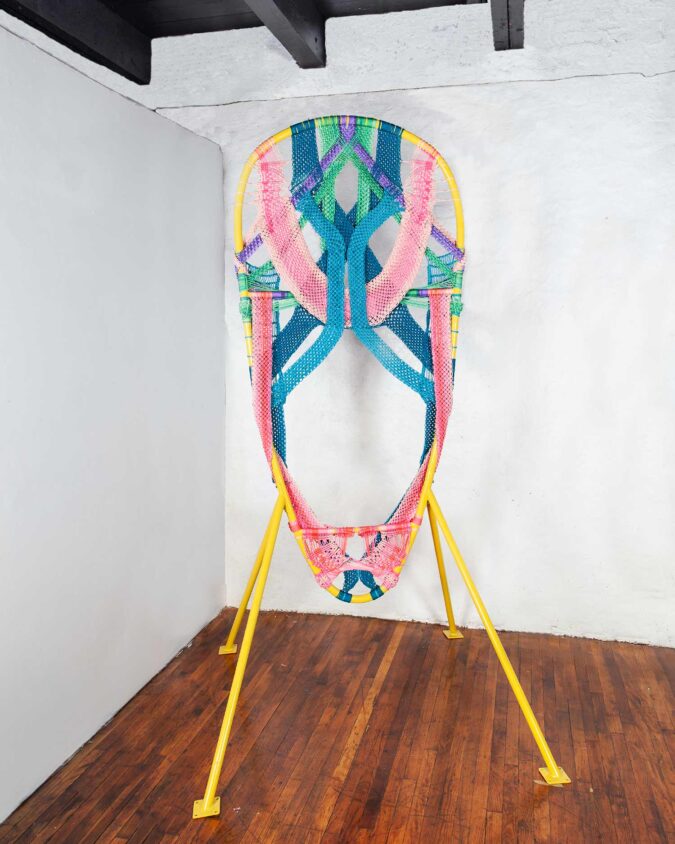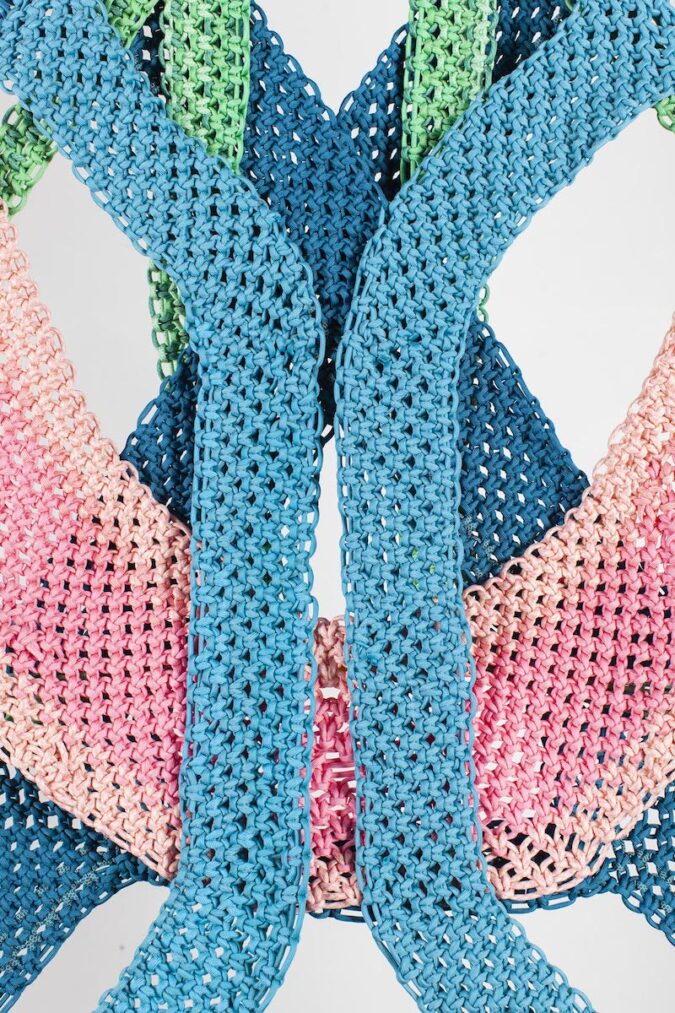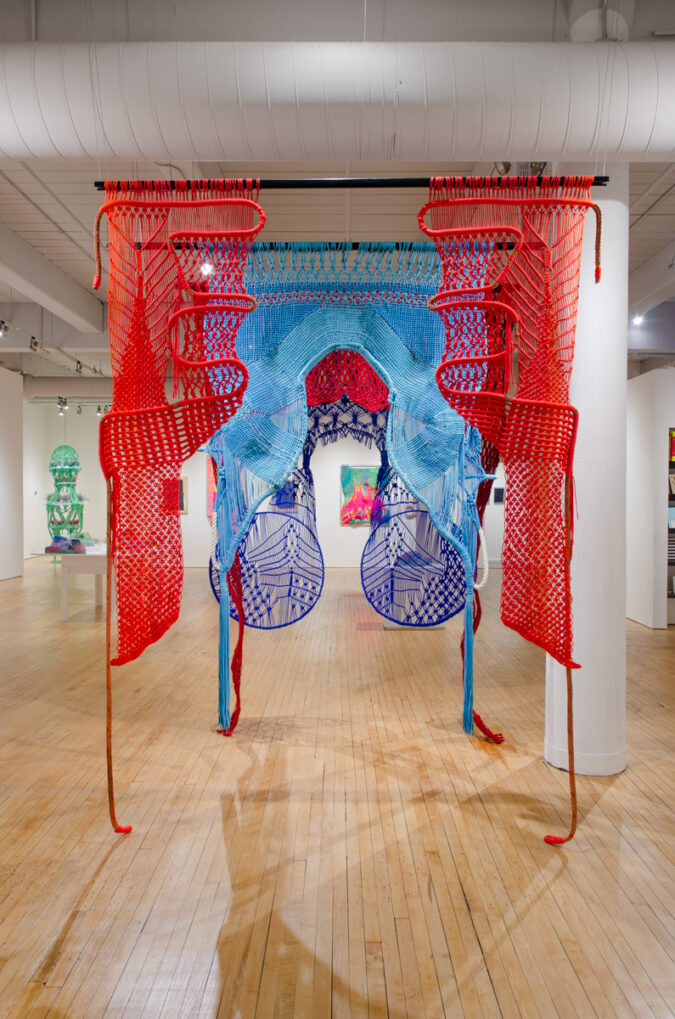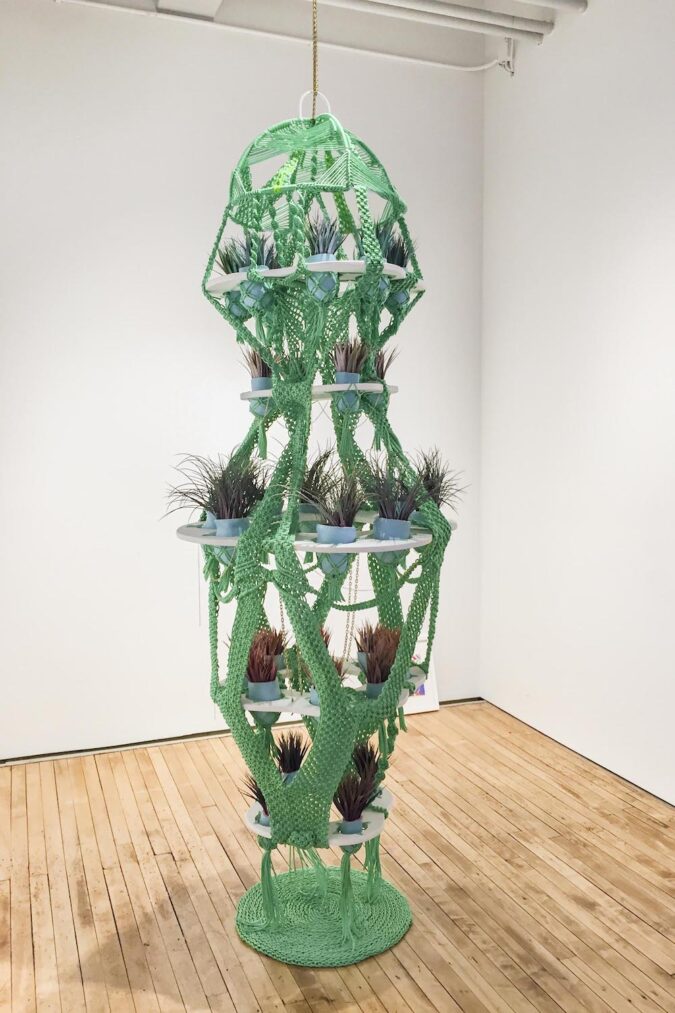Jesse Harrod
Jesse Harrod is an artist whose practice explores embodiment, gender, and sexual identity. Working with multiple media forms and materials, Harrod’s work builds on herstories of 1970s feminist art to offer queer imaginations of the body, from the abject and the grotesque to the humorous. Her practice most centrally contributes to a broader collective effort to redefine the meaning of queer aesthetic form. Harrod’s work has been exhibited in numerous exhibitions throughout the United States and internationally. She has an MFA from the department of Fiber & Material Studies from the School of The Art Institute of Chicago and a BFA from the Nova Scotia College of Art and Design University. She is currently the Head of Fibers & Material Studies at Tyler School of Art in Philadelphia.
Question:
In “Taught Tight Tender Sway”, and many other pieces, we see through one layer to another and another. As we move around the piece it changes. It is not just an example of parallax but makes shifting relationships a palpable metaphor. It is a piece with multiple allusions – doorways, passage, keyholes, walls, curtains, an array of openings. And it is a piece that creates multiple experiences – a painting experience, a sculptural experience, an architectural experience, a decorative experience as well as 2 kinds of temporal experience. We experience time as we move through the piece and by attending to how it is made – knot by knot. Point of view is paramount. Knowledge, perception, and understanding depend on where we are standing, most dramatically whether we are inside or outside. What is it about creating multiple experiences that compels you? Are you ever drawn to singularity? The experiences seem as porous as the forms, one slipping into another. Are you also interested in the distinctions between them?
Answer:
You hit the nail on the head! You are seeing things in the work that are so important to me but that I rarely get to talk about. I’m extremely interested in people having a variety of experiences with my work as well as myself having variety of experiences with the work and I think that desire comes from multiple places and probably some that I’m not even aware of. I have ADHD and as a result I engage best in the world when there are many things happening simultaneously, it allows me greater focus as opposed to if there is one task at hand. I’m someone who will read with the radio and the tv on at the same time
That kind of frenetic energy that I engage in the world with, I am told by neurotypical people, translates or appears in my work as well.
I think because I have what is considered a disability and I’m an educator I’m always thinking about the multiple ways that people learn and take in information. School systems in western culture don’t account for that, including art schools. That being said It isn’t something that I’m intentionally trying to do in my work but it is present in my mind as a maker.
I’m particularly interested in the ways that color and form relate to each other and I distinctly remember seeing Anni Albers husbands, Josef Albers, book “The Interaction of Color” in undergrad and that was mind blowing and felt analogous to thinking about how people do or don’t see each other – it felt like a beautiful metaphor for societal issues. What I garnered from that book has really stuck with me, funnily enough this particular piece “Taught Tight Tender Sway” was specifically influenced by that book. The porosity of the work, the way that you can see through it and it reveals what is behind it is a theme throughout all of my work but this installation , more than others because of the way that its hung, the proximity to the body. It feels really tied to a lot of what I took away from Albers book at the same time it’s also a metaphor for thinking about otherness, queerness, sex and sexuality. I wanted people to be able to move through the work not just stand back and look at it – when I was building it in the studio it became this immersive space and that was so exciting to see how the colors shifted in relationship to each other and how I could control shifts in perception of space and color through the positioning and technique. I often think that what is concealed is far more interesting than what is revealed in almost any situation.
Painting, architecture and decoration are all very important in my work and research. My undergrad was in painting although I teach and run a fibers program and I’m very committed to the politics that drive fiber material studies as a field it’s clear to me as an artist my foundation is in painting and it is probably more present in my work than anything else. I tend to look at painting and architecture more so than I do any other art. Thinking about physical space and its dependency on the body feels like a political act, centering the physical is crucial for me as a person and maker and that exists in fiber-based work as it’s often overtly haptic in a way that is less legible in painting but that’s just because people are less familiar with how a painting is made.
I’m interested in making work that is loud in some way or another. I’m an extremely shy person I feel like my work can speak in ways that I don’t have the capacity to .
I work predominantly with paracord which is one color – so for the most part I work with single colors where you can’t blend or shift the color like you can with paint – it’s part of what interests me in this material, the limitations that I have to negotiate. That’s tied to a lot of the painting I like I tend to be drawn to hard edge painting of the 60s and70s – as well as being an avid comic book fan as a kid which has that graphic sensibility to it. I think that there’s a way that the paracord can mimic that aesthetic – the contained-ness of the color.
I really like your read on time in relationship to the work. It’s a complicated question within fiber conversations. There’s a sort of heroism that some people get really excited about with regards to labor and time in making and I’m interested in the way it relates to labor movements and the relationship to labor in textile fields.
I am far less interested in the conversation of time as a performance of heroism which to me often feels very masculine or patriarchal because in reality having time to make something is an indication of privilege. When people talk about time in a fiber or craft context it seems very de-politicized and that is worrying to me. It often isn’t connected to labor movements or to freedom of time or the politics of leisure or the inherent class privilege to knit a hundred things. Time becomes a focus in fiber processes more so than painting or sculpture because the labor is haptic and evident and there’s a way its relatable – one can imagine making a million knots – and can therefore directly relate that to time whereas with painting there’s a perception of mystery which is encouraged by the institutions, the academy that to me feels really boring and trite, bullshit.
The work allows for multiple reads as you’ve mentioned – multiple points of entry and certainly the visible labor in the work is inevitable in what I do. That rant wasn’t what you were referring to in your question though which is beautifully written – “We experience time as we move through the piece and by attending to how it is made” – That feels really different than venerating someone for having the privilege and skill to do something endlessly. I like the idea of someone moving through the piece by following the line of the rope, I often think of the rope as a drawing tool, as a drawing in space. I start with a drawing on paper and then it becomes dimensional with the rope and changes dramatically from the page but that step from page to rope is a crucial part of my process but the real inquiry is with the material and space.










Cool work!!!!!
Powerful bold work and delightful reflections on it. Love your take on “loud” work and “shy” person. Thanks for the opportunity to learn about your work, Jesse, and thanks Daniel for the wonderful prompts and unique platform.